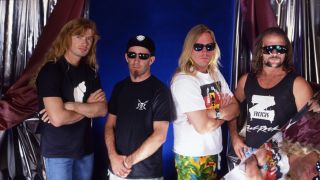Megadeth entered the 1990s on a high. Happily, for co-founder Dave Mustaine and David ‘Junior’ Ellefson, that status was figurative rather than literal.
The debilitating impact of the serious drug habits both men had been cultivating, since investing half of the recording budget allocated to Megadeth’s 1985 debut album (Killing Is My Business… And Business Is Good) in heroin and cocaine, had been brought sharply into focus during the summer of 1988.
Booked to play the biggest show of their lives, in front of 107,000 metalheads on the supporting bill for Iron Maiden’s first headline appearance at Donington’s Monsters Of Rock festival on August 20, the quartet limped through an embarrassingly moribund set, with Ellefson horribly dope-sick. Management immediately pulled a week of prestigious European stadium shows with Maiden, and flew the band home to put Mustaine and Ellefson into rehab.
“I’m lucky, with my intake of drugs and drink, that I didn’t end up as a glob of shit,” Mustaine admitted to Q magazine in 1992. “For five years, I was spending $500 a day on cocaine and heroin. Every single day. [My] loved ones were watching a man become a hollow shell.”

By 1990 however, clean, focused and rejuvenated with the recruitment of guitarist Marty Friedman and drummer Nick Menza ahead of the recording of Rust In Peace, Megadeth were on fire and on the rise.
Two days before their fourth album dropped, the band kicked off an ambitious European arena tour, co-headlining with old friends Slayer. With Testament and Suicidal Tendencies on the under-card, the three-week tour, billed as the Clash Of The Titans, was a triumph, offering all four bands a teasing first taste of what true success might look like. Mustaine and Ellefson were both completely hooked.
“Clash Of The Titans was very strategic for Megadeth,” Ellefson tells us. “It was the stepping stone that took us from being a dishevelled, broken-down, drugged-out shell of a Megadeth in 1988/1989 into being the band that could fill arenas on our own.
“Rust… was our first record with clear minds and clear ambitions. It was interesting to juxtapose where we were in ’90, kinda fresh and going out with Slayer as this new unit, to the end of the following summer where we were ready to go it alone and do things for ourselves. We were shooting for the stars.”
And momentum was building. Megadeth played a run of dates in late 1990 and early 1991 that included shows with Judas Priest and an appearance at the second Rock In Rio festival, where they played to more than 100,000 people on a bill topped by Guns N’ Roses.
That summer, a second Clash Of The Titans tour was announced, with fellow thrash trailblazers Anthrax added to the bill as a third headliner, and a young Seattle band, Alice In Chains, booked as the opening act, to promote their debut album, Facelift, featuring emerging radio hit Man In The Box. Sensing a new window of opportunity at broadcast media for music with attitude, Megadeth knuckled down.
“Every single day we got to a city and into our dressing room, we were writing songs for what would become Countdown To Extinction,” Ellefson recalls. “Ron Laffitte was a terrific manager for us; his icon was Pat Riley [head coach] of the [Los Angeles] Lakers, so he was all about the team and focusing on how you could channel all this talent. He made sure we’d have everything we needed to harness the greatness that was developing in the band at the time. We knew the record after Rust In Peace was going to be the big one, you could just feel it.”

Megadeth ended the Clash Of The Titans run with an arsenal of new songs banked, the likes of Foreclosure Of A Dream and Ashes In Your Mouth shifting away from the more technical focus of Rust In Peace, to emphasise strong melodic hooks and arrangements. Keen to amplify their newly honed accessibility, they enlisted Ozzy Osbourne’s producer, Max Norman, to co-produce.
Sessions started at Burbank’s Enterprise studios in January 1992 and carried through to April, a timeframe encompassing the infamous LA riots, which broke out in furious response to the exoneration of police officers who had been filmed savagely beating motorist Rodney King in March 1991.
“I only live two blocks away from the studio so I could walk there, but the other guys in the band had to drive,” Mustaine told Hammer in 2018. “Nick Menza and David Ellefson both had handguns in the car. I said, ‘You are making a huge mistake there – you get pulled over for any reason, by cops or civilians, and they find those guns in there… well, there’s nothing more wrong than being shot with your own gun.’ We would work feverishly on the record until 6pm, then it was like a school bell ringing and we had to make it home.”
Perhaps subconsciously, the tension bled into the studio. Megadeth had always been one of thrash metal’s more politically astute forces, and Countdown To Extinction seemed to exemplify this more than ever.
The title track had been inspired by environmental concerns (ultimately winning a Humane Society Genesis Award, making Megadeth the only metal band ever to have done so), while the irresistible Symphony Of Destruction, earmarked as the set’s lead-off single, had been inspired by a combination of a World War II documentary advertisement in Time magazine, tense movie thriller The Manchurian Candidate, and an incident that occurred while the band were on the road with rising grunge rock newcomers Stone Temple Pilots.
“Towards the end of that tour, things got really dark,” Mustaine told Rolling Stone in 2017. “We ended up having to stop the tour because there was a riot at the venue in Oregon. They broke the barricade, they rushed the stage, trying to flip the bus over and shit. When you’re a kid, you’re like, ‘Woohoo! This is great!’ but you get a little bit older, it’s not just a couple of crazy people, but it’s, like, a lot of really mad people. It was scary stuff.”
The months leading up to the scheduled summer 1992 release of the quartet’s fifth album had seen something of a cultural coup d’état, as a series of landmark alt-rock releases from Nirvana, Pearl Jam, Soundgarden and more, effectively transformed the music landscape.
But where more traditional metal acts were left high and dry by this sea change, Megadeth seemed to thrive. Whether it was their cutting political insights, streamlined song structures, or simply because their art had been given a platform to connect with more music fans than ever before, Countdown To Extinction was a commercial smash, debuting at No.2 on the Billboard 200 album chart, and ultimately attaining double platinum status in the US alone. Not that the group’s newly engaged and increasingly ambitious frontman was satisfied.
“When we were getting ready for the release date, we were looking at some of the records that were coming out around that time and thought we had a legitimate chance of being in the Top 10,” Mustaine told Hammer’s Dave Everley.
“Well, this artist Billy Ray Cyrus had this stupid song, Achy Breaky Heart, and When Countdown To Extinction came out, it was at No.2. Who’s at No.1? Billy Ray Cyrus! I really obsessed on that, I thought, ‘I got to be No.1 at least once in my life.’”
A disappointed Mustaine could at least take solace in the fact that Countdown… would expose Megadeth to new fans around the world, inspiring others to take up the charge.
“For everyone he’s influenced and the way he inspired things in metal, Dave Mustaine deserves that No.1,” insists Urne bassist/vocalist Joe Nally.
“Symphony Of Destruction is an absolutely massive song; it might be simple but every band wishes they’d got one of those. When I was writing [our debut album] Serpent & Spirit, I immersed myself in albums like Countdown To Extinction and The Black Album to get a feel for those classic stadium riffs.”
“Of the Big 4, Megadeth always seemed to be the most sophisticated,” adds Tesseract/Cage Fight’s James Monteith. “At that point, Megadeth represented metal in the alternative mainstream, because Metallica had moved on to become a stadium rock band. Grunge had cleared off the Dungeons & Dragons-type bands, so clichés took a nosedive, but Megadeth were still up front.”
So up front in fact, that Mustaine was asked to cover the 1992 Democratic Convention for MTV and raise awareness of the company’s ‘Rock The Vote’ campaign, an initiative designed to get America’s youth to register to vote.
“It just seemed like the right thing to do,” he said. “It was shameful the way the public had treated heavy metal people. I thought, ‘You know what, I’m going to go and represent.’ I was the unofficial, unelected representative of the disenfranchised youth of America.”
Ironically, given its title, Countdown To Extinction enabled Megadeth to survive the changing tides of the music industry that wiped out many of their 80s peers, and connect to a whole new audience. In 2012, in recognition of its legacy, the band revisited the album in full for a 20th-anniversary tour, giving Dave Mustaine an opportunity to reflect upon its impact.
“I sometimes have days that I’ve woken up and just thought, ‘Do I matter? Am I still relevant?’” he says. “You know, listening to some of these bands that have come and gone over the years, they were really famous and then all of a sudden they’re gone. That could have happened to us, you know?
But then you go down and you see the success of the Countdown… tour, in Argentina and in Brazil, India and Dubai, playing the record and people singing every song. Everybody has almost the same story – ‘The first record I ever got was Countdown To Extinction.’ It was a pivotal record in our career.”
Countdown To Extinction celebrates its 30th anniversary today, July 1st 2022. For more top-tier Megadeth content, pick up the new issue of Metal Hammer, out now.




